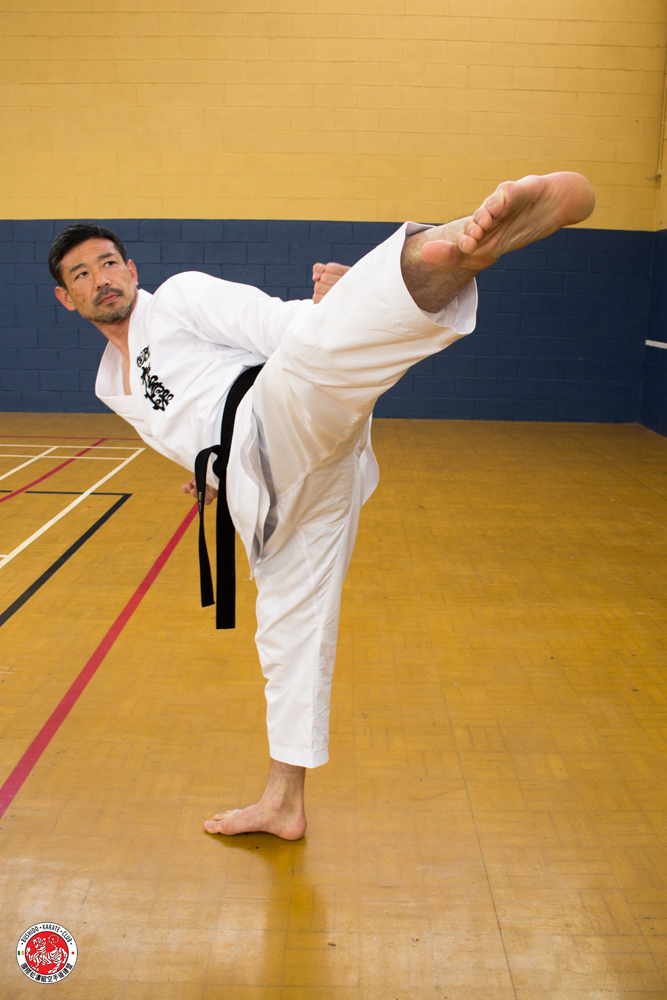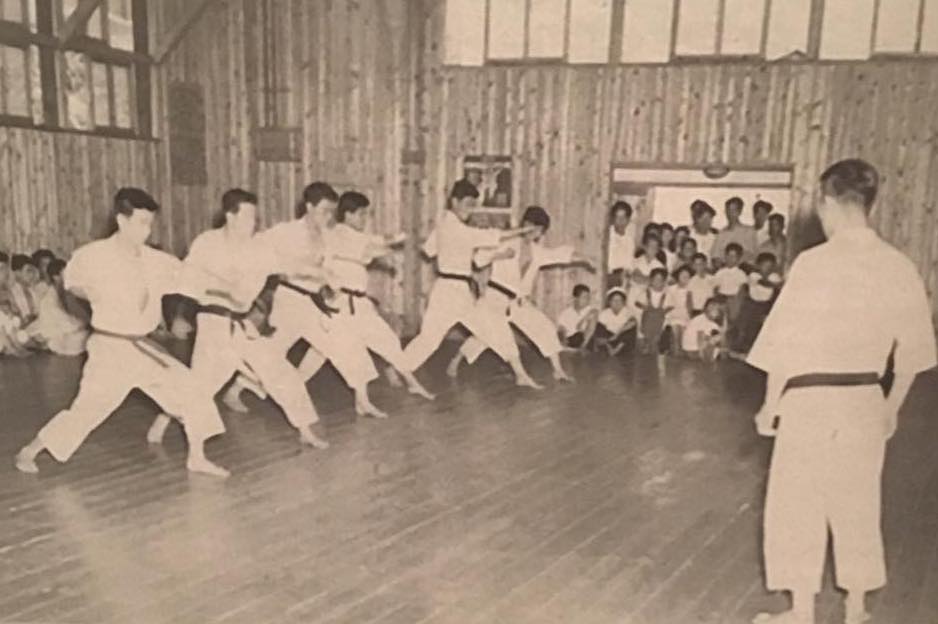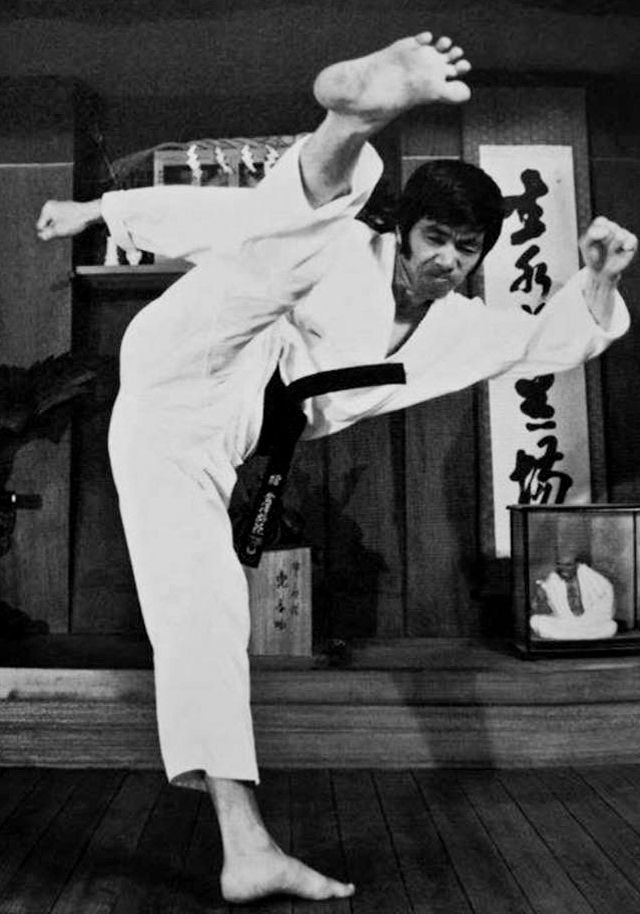A Brief History of Shotokan Karate-Do
By Renshi Aaron Kenneally

Nobuaki Kanazawa Kancho
SKIF Ireland h.President
(Photo by Renshi Aaron Kenneally)
Karate, a martial art celebrated for its precision, discipline, and strength, has a rich history that spans centuries and continents. If you follow it far enough, its origins can be traced back to ancient India, where the seeds of this martial discipline were sown. In this article, we will embark on a historical journey, following the path of Karate.
The Indian Roots
The story of Karate begins with the legendary monk Bodhidharma, also known as Daruma, in Japan. Around the 6th century CE, Bodhidharma made a remarkable journey from India to the Shaolin Monastery in China. There, he introduced Zen Buddhism and introduced a set of physical exercises and fighting techniques that laid the foundation for martial arts.
These Indian martial arts, which included techniques like striking, grappling, and breathing exercises, were incorporated into the training regimen of the Shaolin monks. Over time, this fusion of Indian and Chinese martial arts gave birth to what we now recognise as Kung Fu.
The Spread to Southern China
As kung fu continued to evolve in the Shaolin Monastery, it spread beyond its walls. Southern China became a fertile ground for developing different kung fu styles with unique characteristics and techniques that were more similar to what we know as karate techniques than kung fu techniques.
The Okinawan Connection
The history of Karate takes an exciting turn when we shift our focus to the Okinawan islands. During the 14th century, Okinawa served as a critical trading hub between China and Japan, resulting in cultural exchanges that included martial arts. The indigenous Okinawan martial art known as "Okinawan Te" was influenced by Chinese Kung Fu, leading to a distinct martial tradition.
The Evolution of Karate in Okinawa
Okinawan Te was further developed and refined on the island of Okinawa and had various versions depending on the location within Okinawa, such as Naha Te, Tomari Te, Shuri Te, etc. This process of evolution was driven by necessity, as Okinawans faced a ban on carrying weapons imposed by the ruling Satsuma clan. To defend themselves, Okinawans honed their empty-hand combat skills.
One of the pivotal moments in the history of Karate occurred when Okinawan masters decided that Gichin Funakoshi would be the best person to travel to Tokyo to demonstrate Karate-Do to the Japanese government. The main reason that Funakoshi was chosen was because he was a highly educated professor and the only one who spoke fluent Japanese. This historic event took place in 1922, marking the introduction of Karate to mainland Japan.
The Birth of Shotokan Karate
Gichin Funakoshi arrived in Tokyo in 1922 to demonstrate Okinawan Karate to the Japanese government. Impressed by his skills and teachings, Funakoshi was invited to stay in Japan and teach Karate. He set up his first official dojo (training hall) in 1936. This dojo was located in Mejiro, Tokyo, marking the beginning of Funakoshi's legacy in mainland Japan.
The Origin of the Name "Shotokan"
The name "Shotokan" carries a profound significance. It was created by Funakoshi's students in honour of their master. Funakoshi had a pen name, "Shoto," which he used when signing his poetry and calligraphy. "Shoto" is composed of two characters: "Sho" (æ¾), meaning pine tree and "To" (濤), meaning waves. "Shoto" symbolised the sound of wind blowing through pine trees, a tranquil and poetic image. The second part of the name, "kan" (館), means training hall or place, often associated with a dojo. Hence, "Shotokan" translates to "Shoto's training hall" or "Hall for the cultivation of Shoto's way."
Funakoshi and Kano: A Friendship That Shaped Karate
Gichin Funakoshi, often called the father of modern Karate, had a deep friendship with Jigoro Kano, the founder of Judo. Their close relationship played a crucial role in the development and dissemination of Karate. Funakoshi adopted the belt system from Judo, introducing the coloured belt ranking system to Karate. This system provided a clear progression for students and contributed to the standardisation of Karate techniques and curriculum.
The Spread of Karate to the Western World
Following its introduction to mainland Japan, Karate gradually made its way to the Western world. It gained popularity as a martial art and a form of physical fitness and self-defence. The Karateka (practitioners of Karate) demonstrated their skills through exhibitions and competitions, attracting a global audience.
Shotokan in the Education System

Takushoku University Karate Club
The introduction of Shotokan Karate into the Japanese education system was pivotal in its widespread adoption. One of the key figures behind this integration was Funakoshi's son, Gigo Funakoshi, who was a prominent Karate practitioner and instructor in his own right. In 1924, Takushoku University in Tokyo became one of the first educational institutions to include Karate in its curriculum. Gigo Funakoshi played a significant role in establishing the Karate program at Takushoku University, where Shotokan Karate became an integral part of the physical education department.
The Japan Karate Association (JKA)
The Japan Karate Association was founded in 1949 by Isao Obata, Masatoshi Nakayama, and Hidetaka Nishiyama to promote and standardise Shotokan Karate. Gichin Funakoshi, who was around 80 years old, served as its honorary chief instructor; however, the chief instructor was Masatoshi Nakayama. The JKA aimed to ensure that Karate was taught uniformly and to high standards, emphasising physical and spiritual aspects. Under the leadership of the JKA, Shotokan Karate continued to grow and gain recognition in Japan and internationally. It became a symbol of Japanese martial arts excellence and was taught in various universities and dojos worldwide.
Hirokazu Kanazawa and Training at Takushoku University

Hirokazu Kanazawa Performing Mawashi Geri
Hirokazu Kanazawa, one of the most prominent figures in the world of Shotokan Karate, followed a remarkable journey that led him from Takushoku University to becoming a highly influential instructor within the Japan Karate Association (JKA). At Takushoku University, Kanazawa had the privilege of training under the guidance of some of the most respected Karate masters, including Gichin Funakoshi, Masatoshi Nakayama and Hidetaka Nishiyama.
Under the rigorous training regimen at Takushoku University, Kanazawa honed his Karate skills and developed a deep understanding of the art's technical and philosophical aspects. His talent and dedication to Karate quickly became apparent, and he advanced through the ranks of the Japan Karate Association following his graduation, eventually becoming General Manager for the Foreign Affairs Division and being sent to several locations as a resident instructor to promote Shotokan. In 1977, following a power shift in the Japan Karate Association, Kanazawa parted ways from the JKA.
The Birth of SKIF: Hirokazu Kanazawa's Vision for Shotokan Karate
In 1978, Hirokazu Kanazawa, a distinguished Karateka and former high-ranking instructor in the Japan Karate Association (JKA) embarked on a journey that would leave an indelible mark on the world of Shotokan Karate. His departure from the JKA led to the establishment of the Shotokan Karate-Do International Federation (SKIF), a global organisation dedicated to preserving and promoting the traditional principles of Shotokan Karate.
Key Principles of SKIF
SKIF was built on the foundation of preserving and promoting the core principles of Shotokan Karate:
- Technical Excellence: Kanazawa Sensei strongly emphasised the technical precision of Karate techniques. SKIF's curriculum ensures that practitioners deeply understand the art's techniques and their applications.
- Spiritual Growth: In line with traditional Karate philosophy, SKIF places great importance on character development, discipline, and respect. Kanazawa Sensei believed Karate training should transcend the physical aspects and instil values that contribute to personal growth.
- Global Reach: SKIF's mission was not confined to Japan. Kanazawa Sensei aimed to spread Shotokan Karate worldwide, conducting seminars and workshops in various countries. Today, SKIF has a global presence with thousands of members across the globe.
Conclusion
The history of Karate is a testament to the enduring power of martial arts to transcend borders and cultures. From its humble beginnings in India, through its evolution in China, Okinawa, and Japan, and its subsequent spread to the world, Karate has left an indelible mark on the martial arts landscape.
Today, Karate continues to thrive as a martial art and a way of life, embodying the values of discipline, respect, and perseverance passed down through generations. Its journey from India to the world is a remarkable tale of human innovation, cultural exchange, and the pursuit of physical and spiritual excellence.
Book a Free Trial Class at Bushido Karate Club
Bushido Karate Club is currently accepting new members. Contact us today to book a trial class in Douglas or Carrigtwohill and begin your karate journey. Places are limited so call today to avoid disappointment.
Tel: +353876307006






